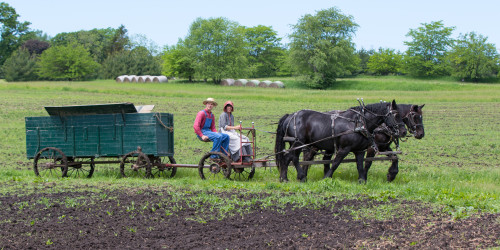By John Busbee
For anyone who thinks museums are dusty edifices filled with dull, motionless artifacts, the ultimate destination to change such an opinion lies in the heart of Iowa where Urbandale’s Living History Farms vibrantly embraces the “Living” part of its name, giving visitors a wealth of experiences spanning centuries.
At LHF, time does not stand still and visitors are encouraged to engage in its time traveling offered through the different eras represented in its vast landscape of agrarian exploration. Last year, visitors from all 50 states and 32 countries journeyed to LHF. By the time guests leave, they have a much better understanding of America’s agricultural heritage and a keener appreciation for the vital, continuing legacy agriculture plays in the American way of life.
The evolution of the landmark property’s ownership itself is historical. The first documented ownership was rooted in the ceding of lands from the Native Americans to the United States through the New Purchase in 1842. The cession of Native American lands launched an explosion of land settling west of the Mississippi River, quickly sweeping across Iowa. Central Iowa experienced land acquisition, too, and John Lewis purchased 160 acres of land in 1849 for $1.25 per acre, the core tract of land that would become Living History Farms.
Lewis sold the land to Des Moines businessman E. R. Clapp 11 years later for $10 per acre. The first connection to a future as Living History Farms entered the story when Clapp sold his land, expanded now to 600 acres, to entrepreneurial businessman Martin Flynn. Flynn was an industrious Irish immigrant who purchased the land at $26 per acre and continued buying land until he had amassed a 1500-acre farming operation.
In 1870, construction began for the crown jewel of Living History Farms. Martin and Ellen Flynn hired brick-makers and carpenters to build a 15-room Italianate mansion on their land. The pragmatic and efficient Flynns established their own brick factory on site, taking advantage of the abundance of clay deposits readily available.
Their home not only rivaled its more famous counterpart in Des Moines, the B. F. Allen residence later to be known as Terrace Hill, but perhaps surpassed Allen’s notable home with incredible modern amenities for that era. The Flynn Mansion boasted hot and cold running water, gas lighting and forced air heat, a veritable palace on the prairie. In a newspaper story at the time describing the house, Martin Flynn stated that he “planned to furnish it in as good style as any house in the country.”
The house was completed in 1871. The same year a very modern, two-story Flynn Barn, still part of Living History Farms, also was completed. Both are on the National Register of Historic Places. The Flynns raised 10 children on what they named Walnut Hill Farm, building it into a notable operation that specialized in purebred Shorthorn cattle and Berkshire hogs.
Martin Flynn continued his entrepreneurial ways, founding Flynn Dairy and Peoples Savings Bank (which became Bankers Trust) and was involved in a variety of other ventures. Equally busy, Ellen Flynn not only raised their children, but also was engaged in the region’s cultural well-being. She founded the Walnut Chapter of the statewide women’s social and benevolent club, The Daughters of Ceres, named after the Roman goddess of agriculture.
Formed in the Flynn home, this chapter held biweekly meetings, with its members taking turns in hosting. From archives at the University of Iowa, the club’s purpose was to discuss upcoming activities and charitable projects, enjoying lunches and socializing. These records also indicated that, “though living on isolated farms, these women did not allow snow nor rain nor heat to deter them from attending meetings for ‘the club meetings fulfilled a need for spiritual and social stimulation away from the everyday household tasks.’”
After Martin Flynn’s death in 1906, his children inherited the farm company and continued the business until 1915, when the Flynn Farm Company sold 800 acres of the Walnut Hill Farm, the mansion, and the barn to the state of Iowa for $200 per acre. The State created the Clive Honor Farm, which grew from its original 15 prisoners from the Fort Madison Penitentiary to become a source of farm products for use in other prisons across the state. At the height of the Great Depression, shipping costs were too great, so the farm closed in 1935.
Superintendent John Wabel supervised the reopening of the Clive Honor Farm in 1941. The new business model had the farm selling produce on the local market, a strategy that netted a profit each year. In 1947, Living History Farms saw a $51,000 profit as its record corn yields won awards.
TO READ MORE ABOUT THIS STORY AND OTHER FASCINATING STORIES ABOUT IOWA HISTORY, subscribe to Iowa History Journal. You can also purchase back issues at the store.

